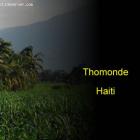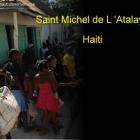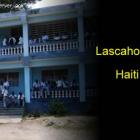ADVERTISEMENT
town - Haiti Observer Blog
town, Haiti Observer Blog. Read the following articles about town
Anse-a-Galets Example of Strong Infrastructure
Anse-à-Galets, cityship in the La Gonâve Arrondissement, part of Ouest Department, is situated on the northeastern coastal area of La Gonâve Island. It is divided into six communes: Grande Source, Palma, Grand Lagon, Petite Source, Petite Anse, and Picmy.
Anse-à-Galets is renowned for its immaculate white-sand beaches. Paired with the hot and steamy clime of the island, it is a tourist magnet. Other parts of Anse-à-Galets's coastline are populated by colonies of large boulders with prominent cliff-faces dripping with abundant vegetation.
One of the few small towns to have an airport, Anse-à-Galets Airport, its airstrip plays host to charter planes arriving from Port-au-Prince. In addition, the Camp Carnages Airport, close by, helps to serve the area well.
Delmas, The Extension Of Port-au-Prince
The commune of Delmas in the Ouest Department is known as the "extension" of the Haitian capital of Port-au-Prince. Covering 80 square kilometers of land, Delmas is part of the capital's expansion and is now housing some 400,000 residents.
The best thing about Delmas is its road construction. Unlike other towns and cities in Haiti, Delmas features an efficient and useable road networks. Its road network provides links to the major highway of Route National No. 1. It also makes it easier for motorists to travel to the Toussaint Louvre International Airport in Port-au-Prince, providing simple access to air travel.
Leogane, The 2010 Earthquake's Epicenter
One town that felt the full blow of the 2010 earthquake in Haiti is Leogane, which is located in Ouest Department. This seaside town was the epicenter of the devastating 7-magnitude earthquake that killed tens of thousands of people. Between 20,000 and 30,000 people were reported dead in the town when the tremor rattled it on January 12, 2010.
The number of casualties is not the only mark of devastation that the disaster left in Leogane. A United Nations assessment also found out that up to 90% of buildings in the town were damaged, making it the worst affected area. The damage it received from the disaster was greater than that in the capital of Port-au-Prince. The Sainte Rose de Lima School, which is considered the heart of the city, was destroyed. As well as other important buildings such as the Saint Croix Hospital and the commercial strip the Grand Rue.
Carrefour in Port-au-Prince And Its Tourism Fallout
The town of Carrefour in the Arrondissement of Port-au-Prince was once recognized as the leading tourist destination in the country. A lot of tourists used to come to this suburb of Port-au-Prince during the leadership of Jean Claude Duvalier. It was a prime spot for tourists, making it popular and boosting its potential. However, the time came that it lost its former glory. When Duvalier's reign ended, the city's tourism potential also lost its spark.
Things got even worse when a 7-magnitude earthquake rocked Haiti, devastating many towns and cities, including Carrefour. Because Carrefour was close to the capital, which was greatly affected by the disaster, the town also received a hard blow. Some 40% of all the town's buildings were destroyed, while the supply of electricity and other basic services were cut down, paralyzing the town.
Poverty And Crime In Cite Soleil
Comfortable living space, safety, security and luxury are some of the things that are uncommon among people living in Cite Soleil, an extremely poor town in the Arrondissement of Port-au-Prince in Ouest Department. As a matter of fact, it is considered one of the poorest and most dangerous towns in Haiti.
Around 400,000 residents live in Cite Soleil without a decent access to electricity. The sewerage and canal systems in the town are in poor condition, while only a few businesses are open to serve the residents. There are some hospitals and only one school. While half of the houses in Cite Soleil were made of cement and metal roof, the other 50% were makeshift shelters built in materials that residents have scavenged.
Mont Organise, Friendly Trade Partner of Dominican Republic
Mont Organise, part of the Ouanaminthe Arrondissement, under the Nord Est Department, lies very close to the Dominican Republic border in the north-east area of Haiti. Two sub-divisions comprise it, Wood Lice and Savanette.
Mont Organise's economy relies on trade activities conducted with the Dominican Republic (DR), whose borders are nearby. Not all trade is legal between the two countries. Smuggling operations exist, and both governments look the other way. Conflict between Haiti and the DR has had an intermittent history, but in some areas they show tolerance. One of them is the smuggling trade.
Ouanaminthe and Free Trade Zone
Ouanaminthe is one of the largest cityships situated within the Nord-Est Department. It has a population numbering 100,000, 10% of whom live in the metropolitan area. Located close to the Dominican Republic border, the Ouanaminthe people cross over via the Massacre River to peddle their wares twice weekly at the Dajabón market.
Ouanaminthe has a well-developed education system. It follows the Haitian model, beginning with Kindergarten, advancing to Primary, then Secondary, and finally University level. Private schools are numerous and church-sponsored. As part of the effort to make education accessible to all residents in Ouanaminthe, the Faith and Joy non-government organization, funded by the Jesuit Refugee Service, is building several new primary schools.
Perches, Small and Struggling City
Perches, one of the smallest cityships in the Fort Liberté Arrondissement, is part of the Nord Est Department. It contains two sub-divisions, Haut-des-Perches and Bas-des-Perches, and a population of barely 8,000.
The chief means of producing income in Perches is through sustainable farming. Pistachio, nut, corn, mango, orange, and lime crops are raised. Livestock farming is also practiced.
Like other cityships within the Fort Liberté Arrondissement, Perches lacks electrical and road systems. If one wants to get to central parts of Perches, they must use hiking trails. Also lacking its own airport, Perches remains difficult to get to, especially for non-government organizations (NGO) there to start infrastructure projects. The nearest airports, Mergellina Harbor and Beverello Harbor lay 10 and 13 kilometers out of the area.
Pilate, Model Library
Pilate, a rural town, is a cityship in the Arrondissement of Plaisance, part of Nord Department. With a population of about 40,445 residents, it is comprised of eight communes: Ballon, Baudin, Ravine-Trompette, Joly, Dubourg, Riviere-Laporte, Margot, and Piment.
Agriculture is the main means of income, and farmers use subsistence-farming methods. Farmlands produce cocoa, yams, rice, and beans. Two crops grown that make up an essential component in the local diet are coffee and peanut butter. The town market, open all week, becomes more crowded on Saturdays, when people come from out of town.
Road infrastructure in Pilate is inferior. Dirt roads and cobblestone streets are hard to navigate by bike or car.
Ranquitte, a Tiny Community
Ranquitte is a rural village placed within the Saint-Rafaël Arrondissement, under the Nord Department. Located in the north-east sector of the island of Haiti, it has a population numbering about 24,000. Three districts comprise it: Bac-à-Soude, Cracaraille, and Bois-de-Lance.
Agricultural farming, the main economic force in the community, relies on coffee growing and small crops of lemons, limes, pineapples, and oranges. The under-production of coffee crop yields, lack of a paved road system, and on-going corruption activities have all ruined the coffee business there. When Ranquitte was first colonized, it had a notable reputation as a center of coffee production.
Our objective is to share with you news and information about Haiti and the people of Haiti. Traditions, habits and the way we were or grew are alive in this site. We highly recommend that you Subscribe to our Newsletter and also share with us some of the things that are memorable and made us unique people.

 Thomonde, Haiti
Thomonde, Haiti  Black Friday Shopping Season
Black Friday Shopping Season  Saint Michel de L 'Atalaye
Saint Michel de L 'Atalaye  Lascahobas, Haiti
Lascahobas, Haiti  Haitian Thanksgiving
Haitian Thanksgiving